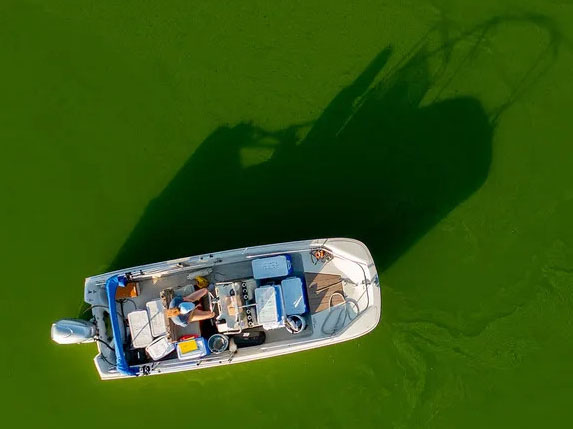College of Sciences Researchers in the News
Delta Urban Soils Lab featured in two print and one television stories
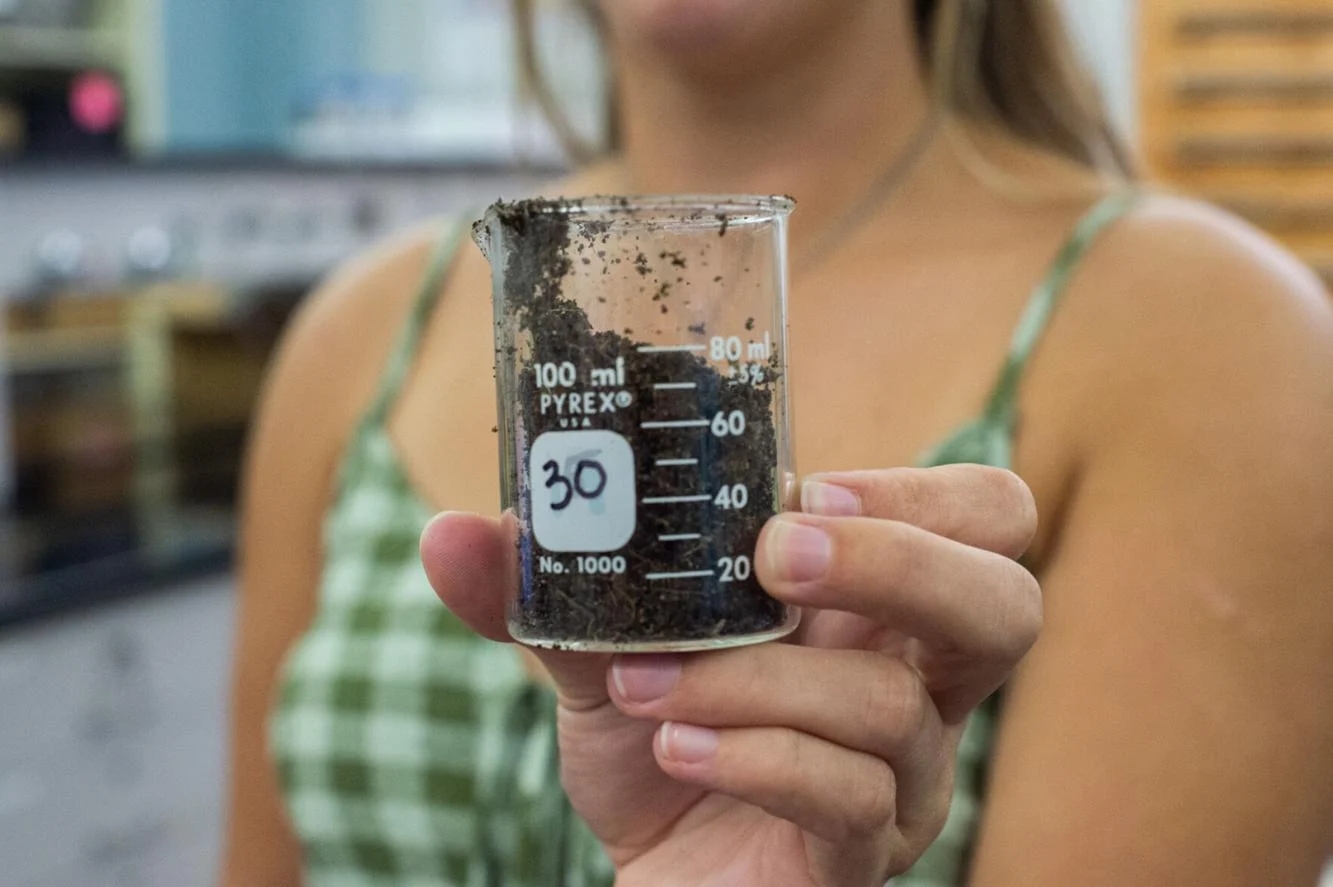
(Graduate student Holly Heafner holds up a soil sample at the Delta Urban Soils Lab Tuesday, October 3, 2023, at UL Lafayette in Lafayette, La. Advocate staff photo by Alena Maschke.)
Dr. Anna Paltseva of our School of Geosciences founded the Delta Urban Soils Lab. The lab offers testing for various types of contaminants, including lead and arsenic. Over the past year, the lab has collected and analyzed hundreds of samples from homes and public spaces in Lafayette free of charge, and is planning to collect hundreds more.
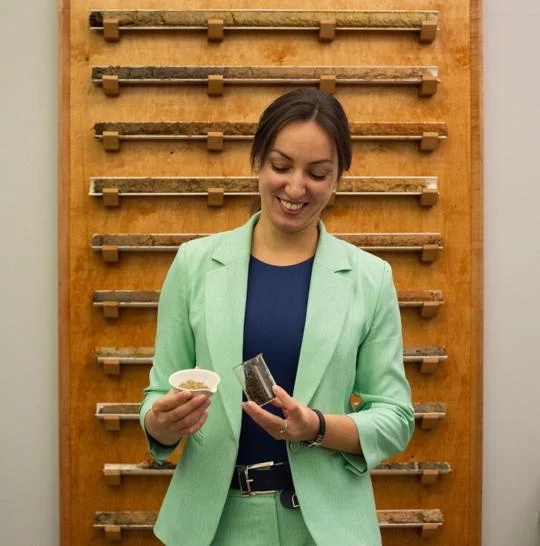
(Professor Anna Paltseva holding up soil samples at the Delta Urban Soils Lab Tuesday, October 3, 2023, at UL Lafayette in Lafayette, La. Advocate staff photo by Alena Maschke.)
Lead-contaminated soil can have adverse health outcomes, especially for children. Now in its second year, a project of the Delta Urban Soils Lab offering free soil testing to Lafayette residents is calling on homeowners to submit samples from their yards for testing. “This helps residents make decisions about their yards, their community, which then protect the children of that community,” said Chris Adams, a planner with Lafayette Consolidated Government, who has helped the lab connect with residents to inform them about the program. “It’s a really important piece of community health.”
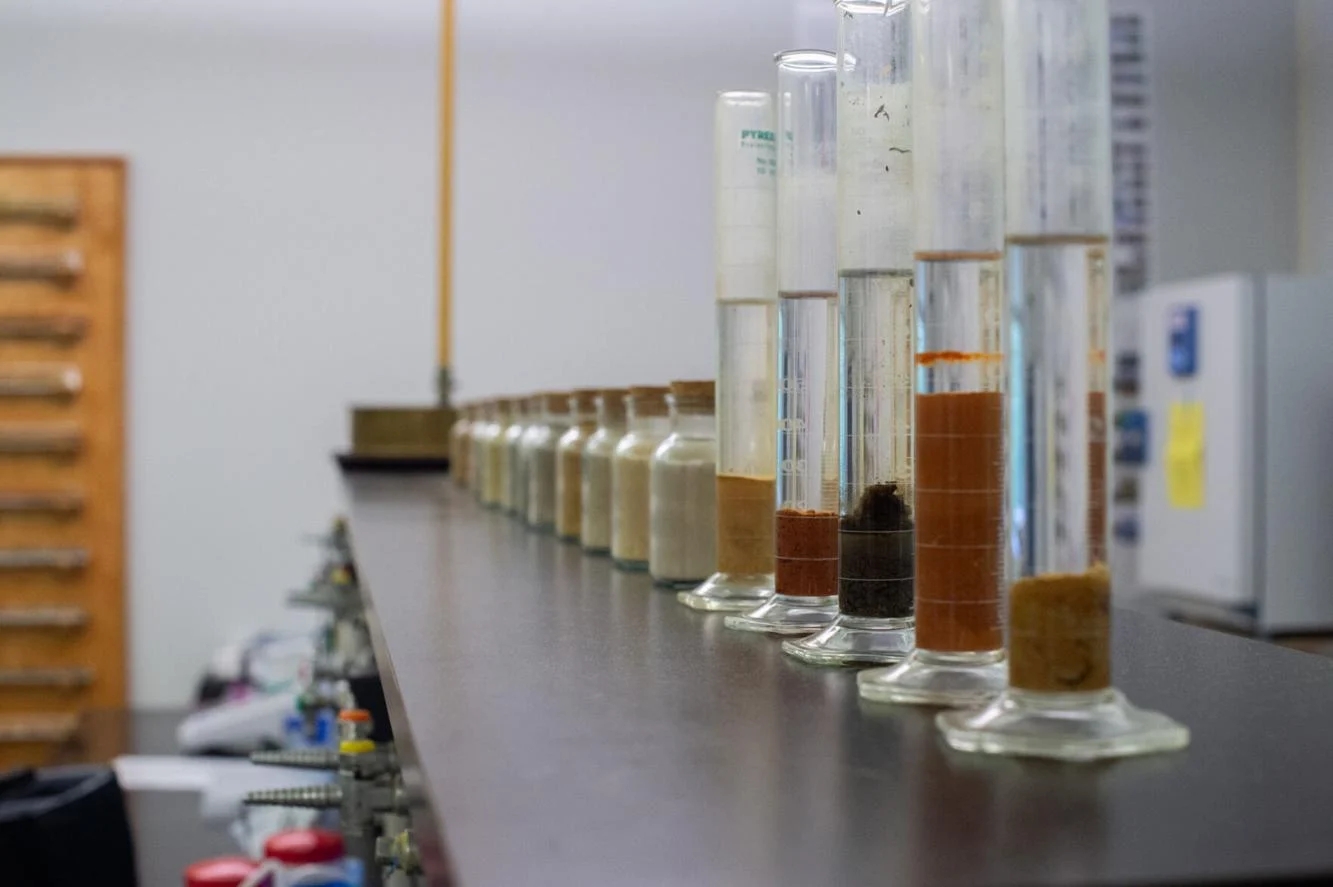
(Soil samples are lined up on a workbench at the Delta Urban Soils Lab Tuesday, October 3, 2023, at UL Lafayette in Lafayette, La. Advocate staff photo by Alena Maschke.)
The good news is that there are many ways to reduce or eliminate exposure, depending on the way the soil is used and the level of contamination. Home gardeners can still grow certain vegetables, like eggplants or tomatoes, even if their soil tests positive for moderate levels of lead, but might steer clear of leafy greens and root vegetables. A yard where lead contamination is detected can still be safe for children to play in — but the contaminated soil should be covered with compost or mulch, to create a protective barrier. “There’s always solutions,” Paltseva said, but it’s important to know the threat in order to combat it.
Funded through a $107,000 grant from the Louisiana Board of Regents, the project has collected roughly 600 samples so far,usually collecting soil from different areas of the property. Over the two-year grant period, which ends in June, the group is planning to collect 1,000 samples total. Some of the samples collected so far have come from public land, while others have been submitted by residents. Members of the field team, made up of graduate and undergraduate students, regularly venture out armed with garden shovels and ziplock bags to collect soil.
At this point in the project, Paltseva and her team are hoping to receive more samples from the south side of town, despite their projections that contamination levels are likely to be lower there. In addition to helping residents make informed decisions, the goal is to create a complete picture of the levels of lead contamination across the city, something that hasn’t been done before in Lafayette. “Very often, small communities stay undiscovered, because scientists focus on bigger cities,” Paltseva said, noting that many scientists have focused their entire careers on studying these issues in Baton Rouge or New Orleans. “I wanted to extend this knowledge.”
Residents interested in having their soil tested can find more information, including a mailing address for samples, on the Delta Urban Soil Labs website. Those outside of Lafayette who want to know more about the composition of their soil can use the lab’s services for a fee.
The text of this news item borrows from the writing of Alena Maschke in her Acadiana Advocate article and her The Current article. The television story about this Delta Urban Soil's Lab project is online at this KATC webpage.
Biologist featured in BBC article discussing algal blooms caused by pollution
(Image credit: David-McNew / Getty Images)
Dr. Beth Stauffer of our Biology Department is featured in the BBC Future article The pollution causing harmful algal blooms by Tim Smedley, published on 11 January 2023.
Here's a brief extract to whet your appetite, "Rising temperatures and pollution have led to an explosive growth of harmful algal blooms, contaminating our drinking water and harming human health. It is the "smell of decay and death", says Beth Stauffer, from the University of Louisiana at Lafayette. "It has a physical presence. This layer of very striking greens and blueish greens…when you put your paddle in it, you can feel it." She's describing the harmful algal blooms (HABs) that used to be more associated with marine environments. But in recent years they've been moving further inland and affecting freshwater systems, too. And scientists such as Stauffer are trying to find out why."
Biologist heads $14 million effort to produce more resilient oysters

Dr. Beth Stauffer, of our Biology Department, heading a $14 million, three-year research initiative to develop oyster broodstock capable of survival in low-salinity environments. Leveraging Opportunities and Strategic Partnerships to Advance Tolerant Oysters for Restoration, or LO-SPAT, is designed to help sustain populations of the shellfish and support the seafood industry. The Louisiana Department of Wildlife and Fisheries is funding the project.
The Advocate - UL leads $14 million research partnership to produce more resilient oysters
Rare Mammoth Tracks Reveal an Intimate Portrait of Herd Life
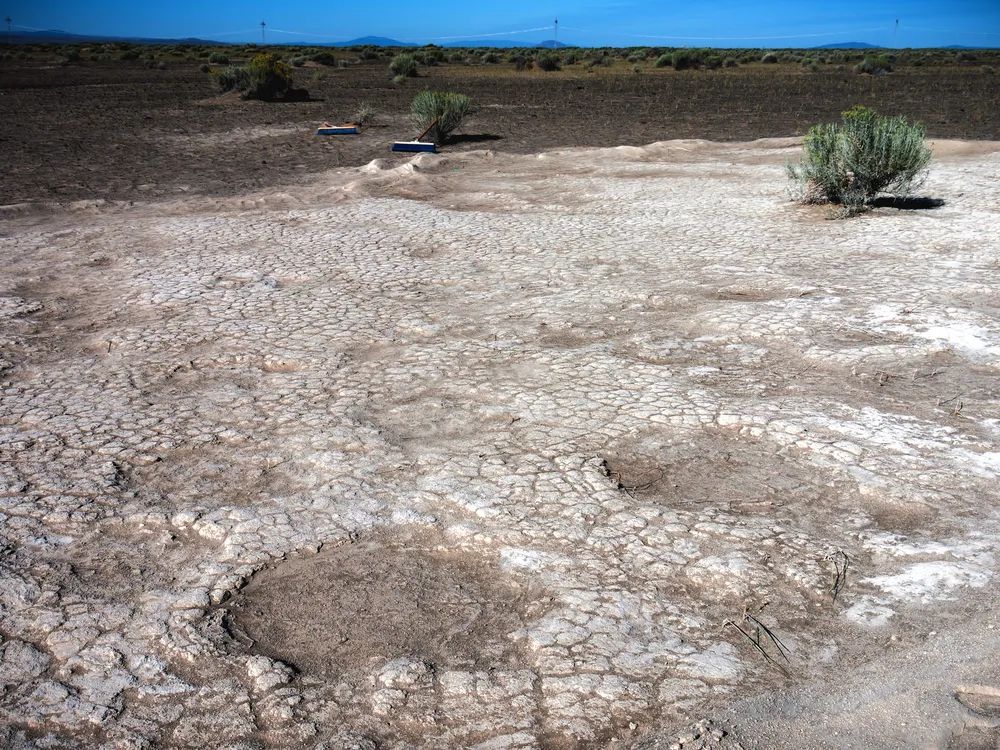
(photo credit: Thousands of years ago, a herd of Columbian mammoths trudged across present-day Oregon to an ancient lake, recording their interactions in the muddy sediments. Greg Shine, Bureau of Land Management Oregon)
Simthsonian: Rare Mammoth Tracks Reveal an Intimate Portrait of Herd Life
James Martin, professor of geosciences and paleontological curator, joined a team of researchers from the University of Oregon and the Bureau of Land Management to unearth and analyze the rare mammoth prints found in Fossil Lake, Oregon. The team was led by Gregory Retallack of the University of Oregon. This Smithsonian article provides a nice entry to learn about the 43,000-years-old tableau of an injured adult and concerned young these researchers unearthed.
Are the strikes of vipers the fastest? Not really!
Discover Magazine: Even Harmless Snakes Strike at Deadly Speed
Huffington Post: Scary Snake Videos Show How Serpents Put Fighter Pilots To Shame
Yahoo! News: Snakes on Planes? Serpents Accelerate Faster Than Fighter Pilots
Vipers are commonly thought to possess the quickest strikes. Not so fast, according to three researchers in the department of biology at UL Lafayette. David Penning, a doctoral student; Baxter Sawvel, a graduate student; and Dr. Brad Moon, an associate professor; have authored an article titled Debunking the Viper's Strike: Harmless Snakes Kill a Common Assumption published in Biology Letters which sheds new light on this assumption. It challenges some popular notions about vipers, namely that their strikes may not be fastest among snakes.
“There’s a misconception, both in common lore, and popular documentaries and scientific literature. It’s always either an implied assumption, or a direct statement, about vipers being the fastest snakes on the planet. We just basically point out that isn’t necessarily true,” explained Penning, the paper’s lead author.
Gravitational waves detected
KATC-TV: Louisiana observatory helps make groundbreaking physics discovery
For the first time, scientists have observed ripples in the fabric of spacetime called gravitational waves, arriving at Earth from a cataclysmic event in the distant universe. This confirms a major prediction of Albert Einstein's 1915 general theory of relativity and opens an unprecedented new window to the cosmos. The gravitational waves were detected on Sept. 14, 2015 at 5:51 a.m. EDT (09:51 UTC) by both of the twin Laser Interferometer Gravitational-wave Observatory (LIGO) detectors, located in Livingston, Louisiana, and Hanford, Washington.
Dr. James Dent (assistant professor of physics) was featured in a local TV (KATC) report explaining this discovery.
Evolution of 'electric organs' in fish and eels
Science Magazine: Genomic Basis for the Convergent Evolution of Electric Organs,
National Geographic: Electric Eels Use Built-In "Taser" to Remotely Stun Their Prey
NPR: A shocking fish tale surprises evolutionary biologists
The Advocate: UL-Lafayette researcher part of team studying electric fishes
Dr. James Albert (professor of biology) and other researchers published an article in Science Magazine explaining how the shock of electric fish has evolved, opening a door to future practical applications. The team worked in Peru to catch native freshwater electric fish and compare their electricity-producing organs to a species of African fish of similar size they acquired through the aquarium trade.
Biologist Joins Exploration of Our Deepwater Backyard
NOAA Ocean Explorer: Our Deepwater Backyard: Exploring Atlantic Canyons and Seamounts 2014
Dr. Scott France (associate professor of biology) and other researchers are studying the New England Seamount chain, which extends about 700 miles to the southeast and consists of more than 30 volcanic peaks. The underwater mountains are dotted with holes and tunnels that provide habitat for a range of species, but are largely unexplored. It is the largest seamount chain in the North Atlantic.
Physicist-Geodynamicist Reconstructs 200 Million Years of Tectonic Plate Dynamics
LiveScience: Tectonic Plates' Patterns Revealed (8-12-2013)
ResearchGate: Organization of the tectonic plates in the last 200Myr
Dr. Gabrielle Morra (assistant professor of physics) and his team have been able to simulate the motion and sizes of tectonic plates over the last 200 million years. To explain the changes in the plates' sizes, the team suggests that the mechanism for plate tectonics may alternate between being plate-driven and mantle-driven. The study finds that, while the number of smaller plates has been relatively steady for the past 60 million years, the large plate distribution has changed considerably.
Physicist offers new approach to dark energy
Phys.org: Physicists propose Higgs boson 'portal' as the source of this elusive entity
Physical Review Letters: Higgs Seesaw Mechanism as a Source for Dark Energy,
It is perhaps the biggest mystery of all: What is causing the universe to come unraveled? A paper by Dr. James Dent (assistant professor of physics) and Dr. Lawrence Krauss, a well-known theoretical physicist and cosmologist, discussed this topic in a paper published online in Physical Review Letters in early August 2013. The universe, which may have begun with a big bang, could ultimately fade to black. For decades, scientists acknowledged that the universe was expanding. But theoretical physics took a new twist in the 1990s, when astronomers discovered that this expansion wasn't happening steadily.

